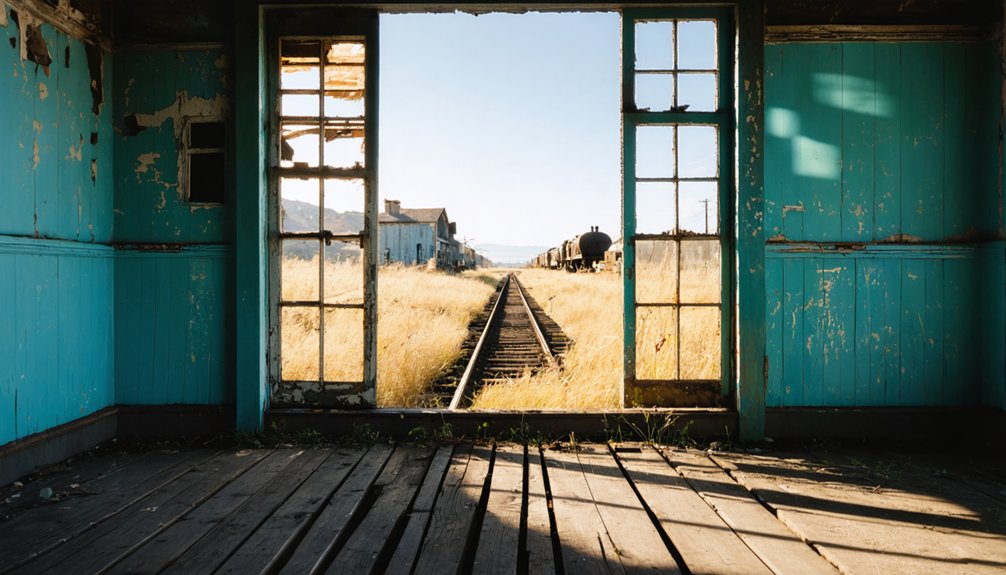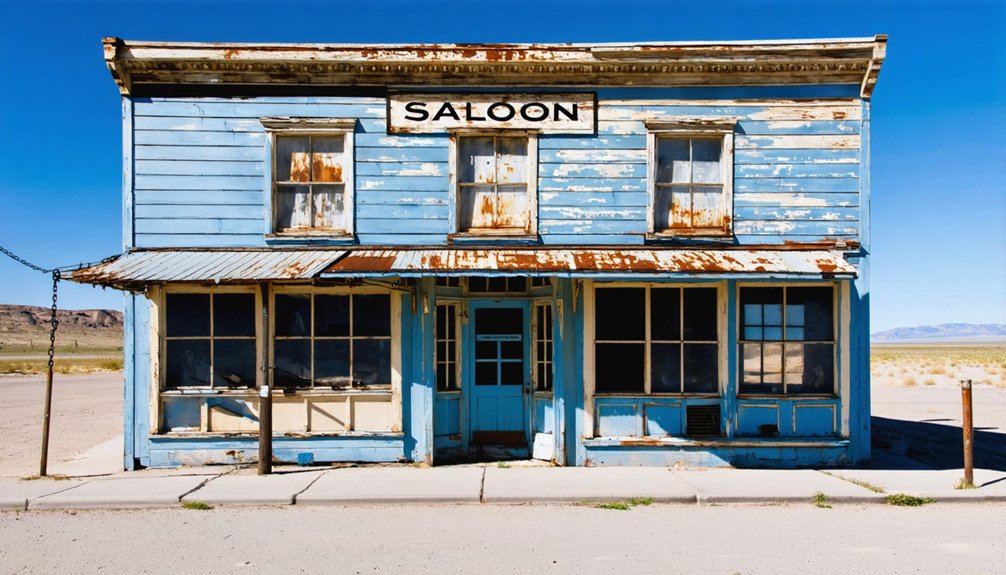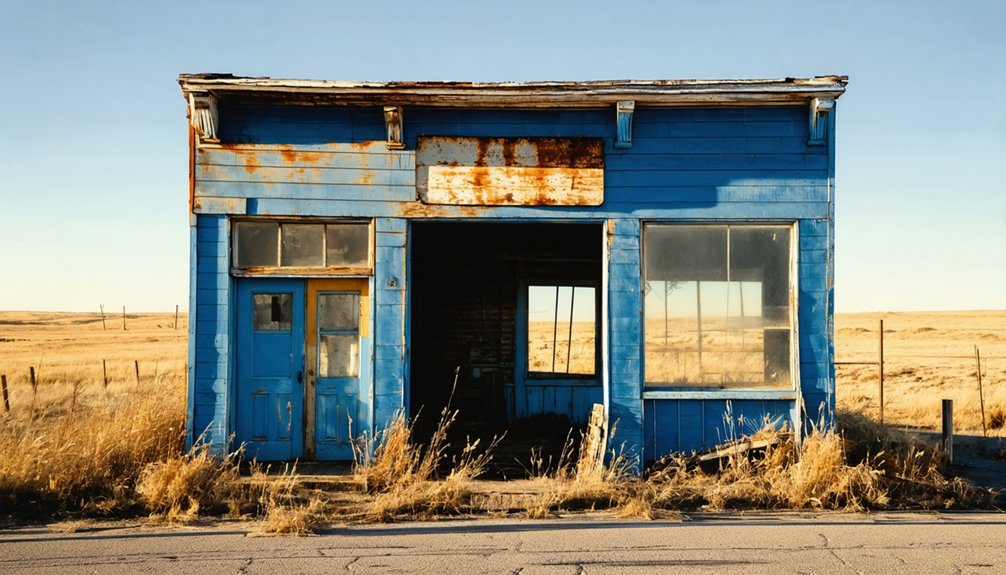You’ll discover Whitewood, South Dakota tucked in the Northern Black Hills, where the first train arrived on November 21, 1887. While not technically a ghost town, this former railroad hub has faced significant population shifts, from 443 residents in 1890 to today’s quieter streets. Historical buildings like the Jones Building and Lane Hotel stand as preserved reminders of its bustling past, when prime commercial lots commanded $500. The town’s rich railroad heritage holds countless untold stories.
Key Takeaways
- Whitewood transformed from a bustling railroad hub in 1887 to a quieter town, with abandoned buildings now attracting ghost town tourism.
- Population fluctuations, from 443 in 1890 to 267 in 1940, reflect the town’s evolution from thriving railway center to semi-ghost town status.
- Shuttered storefronts and quiet streets contrast sharply with Whitewood’s historic past as a dynamic economic center of the Black Hills.
- Historic buildings, including the Jones Building and Lane Hotel, serve as preserved remnants of Whitewood’s former railroad-era prosperity.
- Local tour operators offer specialized ghost town experiences, showcasing Whitewood’s mining history through its abandoned structures and historical sites.
The Birth of a Railroad Town
When the Fremont, Elkhorn and Missouri Valley Railroad reached Whitewood in November 1887, it marked a pivotal moment as the first rail connection between the East and Northern Black Hills.
You’d have witnessed the first train rolling in on November 21st, bringing unprecedented access to this frontier region. For three years, Whitewood served as the line’s terminus until branches extended to Deadwood and Belle Fourche.
The town’s official founding came in 1888, when William Selbie, a railroad employee and land speculator, helped establish the settlement. Philip Bonniwell later opened a successful car dealership and dance hall, adding to the town’s growing commerce.
The Pioneer Township Company surveyed and auctioned lots on Thanksgiving Day 1887, strategically placing the new town on flat land east of Whitewood Creek.
As railroad connections grew, neighboring Crook City’s residents literally moved their buildings to Whitewood, drawn by the promise of prosperity. The bustling railway hub soon operated fourteen daily trains, transforming the town into a vibrant social center.
From Boom to Bust: Economic Evolution
The bustling railroad town of Whitewood quickly developed into a thriving economic hub after its 1887 founding.
In 1887, Whitewood burst onto the scene as a dynamic railroad center, transforming rapidly into a flourishing economic powerhouse.
You’d find a vibrant mix of hotels, saloons, and essential businesses serving both locals and travelers, with prime commercial lots selling for up to $500. Today, the town maintains an impressive average household income of $77,060. Local gardeners helped establish the area as the “breadbasket” region, producing abundant fruits and vegetables for the community.
The town’s economic resilience was tested as transportation changes reshaped its destiny:
- Served as a vital shipping point for livestock, wool, and grain during its railway terminal peak
- Attracted businesses and residents from Crook City after becoming the preferred railroad stop
- Maintained stability through agricultural production even as mining activity declined
Preserving Historical Architecture
Standing as proofs to Whitewood’s rich heritage, several historical buildings showcase the architectural diversity that emerged during the town’s railroad era.
You’ll find iconic structures like the Jones Building and Lane Hotel carefully preserved through community involvement and dedication to architectural preservation. Similar to ghost towns throughout South Dakota, some structures stand in various states of disrepair.
The town’s preservation efforts face ongoing challenges, from securing adequate funding to protecting these treasures from natural threats.
But you won’t find the community backing down – they’re actively engaging in initiatives like the Spring Tour and hosting events in historical venues such as the Presbyterian Church’s fellowship hall.
Local historians, including Mary Livingston, work tirelessly to document and maintain these architectural gems. Historical photos and records displayed at City Hall help educate visitors about the town’s architectural evolution.
Digital archiving and historical markers now complement traditional preservation methods, ensuring Whitewood’s 125-year legacy endures for future generations to explore.
Life in Early Whitewood
Life in early Whitewood centered around the bustling railroad station, where you’d find freight teams loading supplies and townspeople gathering to conduct business or await news from the East.
You’d see ox teams and mule teams hauling relocated buildings through the streets as the town rapidly developed after the railroad’s 1887 arrival, transforming from a sparse settlement into a proper railway stop. The town’s development included mining activities that shaped the economic landscape.
Community spirit flourished through events like the “Whitewood Picnic Day” and the establishment of churches, as settlers worked to build a cohesive town from their diverse backgrounds of homesteaders, railway workers, and business speculators. The town’s early settlers found success in stock and dairying, with the surrounding grasslands providing excellent grazing opportunities.
Railroad Town Daily Activities
As steam whistles pierced the morning air in 1887 Whitewood, fourteen daily trains transformed this Black Hills outpost into a bustling hub of commerce and social activity.
You’d find railroad schedules posted at the depot, where passenger experiences ranged from emotional reunions to business dealings. The station buzzed as locals gathered to collect mail, send telegrams, and ship their goods to eastern markets. The Fremont and Missouri railroad’s arrival that November established Whitewood as the line’s terminus for three full years.
- Daily freight trains loaded with lumber, cattle, wool, and grain connected local producers to wider opportunities.
- The depot served as the town’s social heart, where you’d catch up on news while waiting for parcels.
- Year-round rail access in the protected foothills meant you weren’t isolated, even during harsh Dakota winters.
Your day’s rhythm followed the trains’ arrivals and departures, marking Whitewood as a true railroad town where freedom of movement and commerce thrived.
Building Pioneer Community Spirit
While Whitewood’s official incorporation came in May 1888, pioneer spirit had already taken root through remarkable displays of community determination. You’d have witnessed neighbors helping neighbors haul entire buildings from Crook City to establish Whitewood’s new business district overnight, showcasing the raw frontier grit that defined these early settlers.
Community involvement flourished through shared labor at homesteads, worship at the Danish church built in 1887, and children’s education at nearby schools like the Galena schoolhouse. Located in historic Lawrence County, Whitewood exemplified the pioneering values that shaped the region’s development.
Pioneer celebrations became cornerstones of local identity, with events like Whitewood Picnic Day in 1912 strengthening bonds between rural families. The railroad station served as more than just a shipping point – it was where you’d connect with fellow pioneers, share news, and maintain essential links to the wider region.
The Great Railroad Migration

From the moment the first railroad line reached the Dakotas in 1873, connecting Iowa to Vermillion and Yankton, South Dakota’s landscape changed forever.
The rapid railroad expansion transformed remote prairies into bustling settlements, as companies actively recruited settlers with promises of free land claims and prime farming opportunities.
Railroad companies lured pioneers westward, converting empty grasslands into vibrant communities through promises of fertile farmland and homesteading opportunities.
Settlement patterns followed the iron rails, with entire communities sometimes relocating to be closer to these crucial transportation arteries.
- You could travel faster and more efficiently by train compared to covered wagons, revolutionizing the settlement experience.
- Railroad companies shaped the region by platting new towns and providing year-round access to essential supplies.
- The rail system sparked the Great Dakota Boom, helping increase South Dakota’s population from 12,000 to over 320,000 by 1890.
Notable Landmarks and Buildings
When you visit Whitewood today, you’ll find several well-preserved commercial buildings from its railroad heyday, including the Lane Hotel, Jones Building, and historic Whitewood Banking Company.
The town’s religious heritage remains visible through the Methodist Church and the United Presbyterian Church, with the latter featuring distinctive stained-glass windows installed around 1911.
Unlike many South Dakota ghost towns that have completely vanished, Whitewood’s historic district maintains its structural integrity, with most buildings still standing and accessible to visitors.
Historic Commercial Buildings
As the Fremont, Elkhorn, and Missouri Valley Railroad reached Whitewood in 1887, a remarkable collection of Commercial Style buildings emerged to establish the town’s vibrant business district.
You’ll find two-story masonry structures with large storefront windows that once housed bustling businesses, showcasing the practical commercial architecture of South Dakota’s frontier era.
- Many original buildings were relocated from nearby Crook City as residents sought to capitalize on the new rail access.
- The buildings served multiple purposes, with ground-floor retail spaces and upper-level residential or office areas.
- While most interiors have been altered, the exterior facades retain much of their historic character.
These structures, though some now vacant, stand as monuments to Whitewood’s economic heyday when it served as a major shipping point for livestock, wool, fruit, and milled grain.
Religious Structures Standing Today
The religious structures of Whitewood tell a compelling story alongside its commercial heritage.
You’ll find two significant examples of religious architecture that have stood the test of time: the Methodist Church and Lutheran Church, both representing the town’s foundational pillars of faith. These historic buildings weren’t just places of worship – they served as crucial community gathering spaces in Whitewood’s early days.
As you explore the Black Hills region, you’ll discover how these churches remain important landmarks of Whitewood’s cultural identity.
Today, you can visit these preserved structures, which continue to draw history enthusiasts and tourists interested in the area’s past. The ongoing preservation efforts guarantee that these religious buildings stand as living symbols of Whitewood’s rich heritage in South Dakota.
Population Shifts Through Time

Since its establishment as a railroad town in 1888, Whitewood City’s population has undergone significant fluctuations, starting with 443 residents in 1890.
You’ll find dramatic demographic changes throughout its history, with notable declines in the early 1900s followed by periods of population stability. The town experienced its most substantial growth during the 1960s, when numbers jumped from 470 to 689 residents.
- The population hit its lowest point in 1940 with just 267 residents
- The town reached its peak population of 891 in 1990
- Recent projections show promise with expected growth to 979 residents by 2025
While you’ll notice the population has never exceeded 1,000 residents, Whitewood City’s resilience is evident in its ability to maintain a stable community despite rural challenges.
Legacy of the Black Hills Region
Located at the heart of America’s sacred landscape, Whitewood City’s destiny remains inseparable from the Black Hills’ rich geological and cultural heritage.
When you visit today, you’ll witness the profound legacy of this region, where ancient granite formations shaped by volcanic activity millions of years ago cradle a complex history of human civilization.
The Black Hills stand as a hallmark of both triumph and tragedy – from the sacred grounds of Native heritage spanning 10,000 years to the transformative gold rush that forever altered the landscape.
You’ll find yourself at the crossroads of competing narratives: the Lakota’s enduring spiritual connection to Paha Sapa and America’s pioneering spirit embodied in landmarks like Mount Rushmore, all set against a backdrop of dense pine forests and dramatic spires.
Ghost Town Tourism Today

Modern ghost town tourism in Whitewood City paints a stark picture of America’s shifting travel landscape, where you’ll find shuttered storefronts and quiet streets that once bustled with activity.
Like many historic sites facing economic challenges, Whitewood City reflects broader tourism industry struggles, with visitor numbers dropping and local businesses struggling to survive.
- You can explore abandoned buildings that once housed thriving businesses, offering a glimpse into the area’s rich mining history.
- Local tour operators have adapted to changing tourism patterns by offering specialized ghost town experiences.
- The site serves as a stark reminder of how shifting economic forces can transform once-prosperous communities.
Despite these challenges, Whitewood City’s authentic Wild West character continues to draw history enthusiasts seeking an unfiltered glimpse into America’s frontier past, though in notably smaller numbers than before.
Frequently Asked Questions
What Indigenous Tribes Originally Inhabited the Whitewood Area Before Settlement?
You’ll find the Sioux Nation, particularly the Lakota, were dominant, with rich tribal legends connecting them to the Black Hills. Earlier inhabitants included Mandan, Arikara, Cheyenne, and Crow peoples.
Are There Any Reported Paranormal Activities in Whitewood’s Abandoned Buildings?
Like a blank canvas waiting for stories, you won’t find documented ghost sightings or haunted locations in Whitewood’s abandoned buildings. Historical tours focus on preserving the town’s authentic architectural heritage instead.
What Was the Average Property Value in Whitewood During Its Peak?
You won’t find exact property values recorded, but considering the historical economy and property market trends during the 1890s peak, homes likely ranged from $800-$2,000 based on regional comparisons.
Did Any Famous Outlaws or Historical Figures Ever Visit Whitewood?
Like a blank page in history’s book, you won’t find documented outlaw sightings or historical visits from famous figures in Whitewood. The town’s story centers on railroad workers and local settlers instead.
What Happened to the Original Railroad Tracks and Station Infrastructure?
You won’t find Whitewood’s original railroad tracks today – they were removed as rail traffic declined post-WWII. The station infrastructure wasn’t preserved, falling victim to abandonment when automobiles replaced train transport.
References
- https://www.youtube.com/watch?v=yVWWqwcGTt0
- https://www.youtube.com/watch?v=_0WNYsFLSLA
- https://lawrencecountyhistory.blogspot.com/2013/04/
- https://www.everythingsouthdakota.com/whitewood-south-dakota/
- https://en.wikipedia.org/wiki/List_of_ghost_towns_in_South_Dakota
- https://b1027.com/south-dakota-has-an-abundance-of-ghost-towns/
- https://cityofwhitewood.org/visitors
- https://deanebarker.net/other/sd-history/0716/
- https://www.spearfishhistory.org/2016/02/whitewood-history-and-homesteading-laws.html
- https://www.sdhspress.com/journal/south-dakota-history-5-2/railroads-and-the-settlement-of-south-dakota-during-the-great-dakota-boom-1878-1887/vol-05-no-2-railroads-and-the-settlement-of-south-dakota-during-the-great-dakota-boom-1878-1887.pdf



